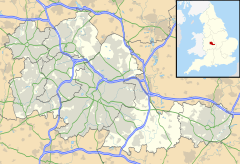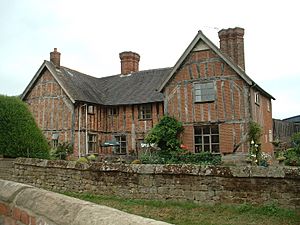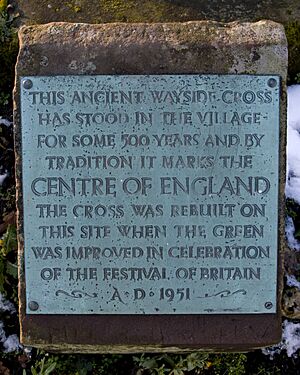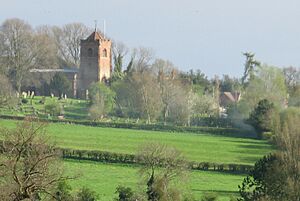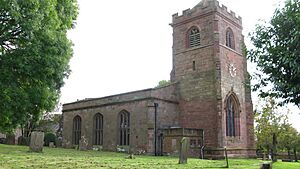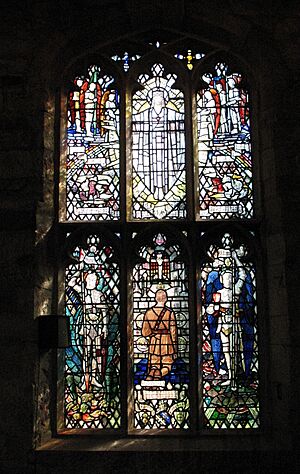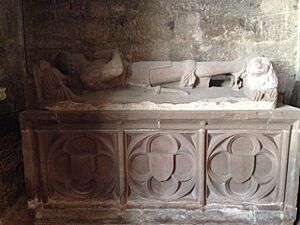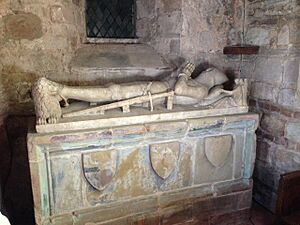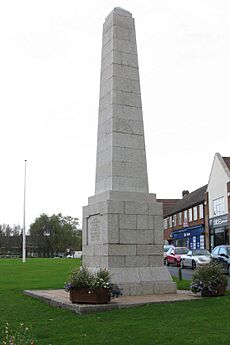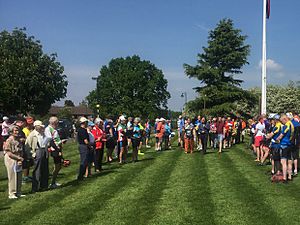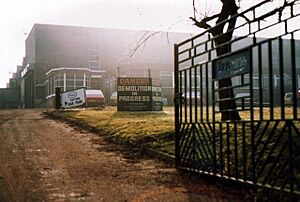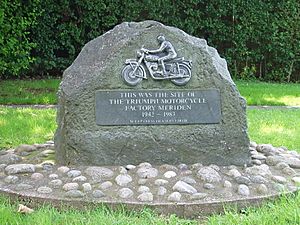Meriden, West Midlands facts for kids
Quick facts for kids Meriden |
|
|---|---|
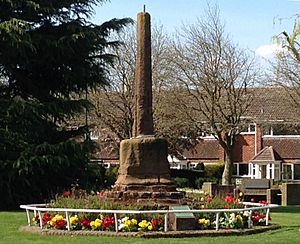 The traditional centre of England |
|
| Population | 2,719 (2011.Ward) |
| OS grid reference | SP240824 |
| Civil parish |
|
| Metropolitan borough |
|
| Shire county | |
| Metropolitan county | |
| Region | |
| Country | England |
| Sovereign state | United Kingdom |
| Post town | COVENTRY |
| Postcode district | CV7 |
| Dialling code | 01676 |
| Police | West Midlands |
| Fire | West Midlands |
| Ambulance | West Midlands |
| EU Parliament | West Midlands |
| UK Parliament |
|
Meriden is a village in the West Midlands, England. It is part of the Metropolitan Borough of Solihull. Historically, Meriden was part of Warwickshire. It is located between the cities of Birmingham and Coventry.
The village is in a green countryside area known as the Meriden Gap. It is about 12 miles (19 km) east-southeast of Birmingham and 7 miles (11 km) west-northwest of Coventry. In the Domesday Book, a very old survey from 1086, Meriden was called "Alspath". The area around Meriden is also a parliamentary constituency (an area that elects a Member of Parliament) that shares its name. In 2011, about 2,719 people lived in Meriden.
Contents
Meriden's Past: A Look at History
Early Days and Old Names
People have lived in the Meriden area since the Stone Age, which was thousands of years ago. Tools from that time have been found here. Bronze Age swords have also been discovered.
The village's first name was Alspath. This name means "Aelle's path" in Old English. The original village was built around the parish church, overlooking the current village.
In 1086, the Domesday Book listed Alspath as belonging to Godiva, a famous countess. After the Norman Conquest, the area became part of the Forest of Arden. Over time, the main road from London to Chester and Holyhead became very important. This road encouraged the village to grow in a new spot. The name 'Meriden' comes from Old English words meaning "pleasant valley." Between the 1400s and 1600s, the name 'Meriden' slowly replaced Alspath as the village grew.
Village Growth and Changes
In the late 1000s, Meriden was very small, with only about nine families. By the time of King Edward I (1272–1307), it was a busy community. By the 1500s, the village was much larger. An old travel guide from 1675 described Meriden as a "scattering village consisting chiefly of inns." This means it had many places for travelers to stay. By 1686, 290 people lived there, and by 1811, the population had grown to 817 people in 152 homes.
Meriden was also a place where cattle were brought and sold in the 1500s. Animals would drink from the village pond before being taken to markets in Coventry or Berkswell.
The main road through Meriden, which connected London to Chester and Holyhead, became very important for trade. In 1723, part of this road became a turnpike, meaning travelers had to pay to use it. In 1810, Thomas Telford, a famous engineer, improved the road. He made Meriden Hill lower, creating a new, straighter path. This "Telford road" was the main route between Coventry and Birmingham until 1958, when a new, wider road (the A45) was built around the village.
Lords of Meriden
After the Norman Conquest, the ownership of Meriden changed hands many times. Important families like the Earls of Chester and the Earls of Derby owned it.
One early Norman owner was Ivo of Alspath. He built the main part of the current St. Laurence church around 1150. After he died, his four daughters divided the land into different areas, including the site of Moat House farm and Alspath Hall.
Another important lord was Gerard II of Alspath (died 1282). He was involved in the escape of Roger Mortimer, 1st Earl of March from the Tower of London. His wife, Millicent, gave her name to Millisons Wood, an area at the east end of the village.
Meriden's Connections to Big Events
Meriden itself has not been a major place in English history. However, it is close to several important castles:
- Maxstoke Castle, about 3 miles (5 km) north, was a favorite home of Lady Margaret Beaufort, the mother of King Henry VII.
- Kenilworth Castle, about 8 miles (13 km) south, was the site of the longest siege in English history.
- Warwick Castle, about 15 miles (24 km) south, was the home of Warwick the Kingmaker.
The escape of Roger Mortimer from the Tower of London, one of only two such escapes in history, has a Meriden link. Gerard Alspath, a lord of Meriden, was involved in this escape.
Queen Elizabeth I stayed at a house in Meriden in 1575, which is now the site of Meriden Hall.
In 1605, Sir Richard Walsh, who owned Walsh Hall in Meriden, helped capture the last people involved in the Gunpowder Plot.
Just before the English Civil War began in 1642, the King's army camped on Meriden Heath. In 1745, during the last of the Jacobite rebellions, government forces also gathered on Meriden Heath to stop Bonnie Prince Charlie.
The famous novelist George Eliot often visited her sister in Meriden until 1854. Her sister is buried in the churchyard of St. Laurence's church.
In 1897, a school called Meriden School was founded in Sydney, Australia. It was named after this village because the founder's husband had happy childhood memories of holidaying here.
The famous grindcore band Napalm Death was formed in Meriden in 1981.
The 'Centre of England'
Meriden was thought to be the centre of England as early as 1829. However, in 1920, it was found that the true geographical centre is actually elsewhere.
On the village green, there is a stone monument with a plaque that says Meriden is the 'Centre of England'. This monument is called the 'sandstone cross'. It used to have a cross on top, but that was lost many years ago. The monument has been moved a few times and is now in its current spot on the green since 1952–1953.
Also on the village green is a special bench. It remembers Walter MacGregor 'Robbie' Robinson, who died in 1956. He was known as 'Wayfarer' and helped make cycle touring popular in the UK from the 1920s. The Cyclists' Touring Club put the bench there.
St. Laurence Parish Church
The parish church of St. Laurence was built where a simpler Saxon church once stood. That first church was dedicated to St. Edmund and was built by Lady Godiva before the Norman Conquest.
The current church was built in several stages. The main part of the church (the nave and chancel) was finished by the late 1100s. It was built in the Norman style.
The church was made bigger in the 1200s and 1300s. In the 1400s, the north side was added, and the Norman roof was replaced.
Around 1831, parts of the church were rebuilt to make more space for people. In 1883, the church was restored again. Old wooden ceilings from the 1400s were uncovered during a restoration in 1924. More work was done on the roof and tower around 2006–2010.
Inside the church, you can see two old stone statues called effigies.
One effigy is of John Wyard, a soldier from the late 1300s. The other is thought to be Sir Thomas Bottiler, who died in 1460. There is also a squint, which is a small opening that allowed people in a side chapel to see the main altar.
The church is dedicated to Saint Laurence (or Lawrence). This could be Lawrence of Rome, an early Christian martyr, or Laurence of Canterbury, who became the second Archbishop of Canterbury.
The Heart of England Way, a long walking path, goes through the churchyard.
National Cyclists Memorial
Meriden is home to a tall stone monument called an obelisk. It is dedicated to the cyclists who died in the First World War. Each year in May, cycling groups hold a special service on the green to remember them. The memorial is 30 feet (9 meters) tall and made of grey granite. It was first shown to the public on May 21, 1921, with over 20,000 cyclists present.
The village's own war memorial is on Berkswell Road. It is a small shrine with a statue of Jesus on the cross. This land was given by Letitia Banks, whose husband, Captain Edward Banks, was the first person from Meriden to die in World War I. He died in 1915 and is remembered in a stained glass window in the church.
Triumph Motorcycles
From 1941 to 1983, Meriden was famous for its large Triumph motorcycles factory. The original factory in Coventry was destroyed during World War II.
Famous actor Steve McQueen and stuntman Bud Ekins visited the factory in 1964 to pick up their special Triumph motorcycles.
In 1973, workers at the Triumph factory protested against the new owners, Norton Villiers Triumph (NVT), to stop the factory from closing. The government then lent money to the Meriden Workers Co-Operative, a group of workers who took over the factory. They continued to make Triumph motorcycles. The story of this worker takeover was even made into a play.
The co-operative eventually closed in August 1983, and the factory was torn down the next year. A new company, Triumph Motorcycles Ltd, was started in 1984 and moved to Hinckley, Leicestershire.
Today, houses are built on the old factory site in Meriden, in an area called Millisons Wood. Some of the street names there are named after Triumph motorcycle models, like Bonneville Close and Daytona Drive. A plaque also stands there to remember the factory.
See also
 In Spanish: Meriden (Midlands Occidentales) para niños
In Spanish: Meriden (Midlands Occidentales) para niños


